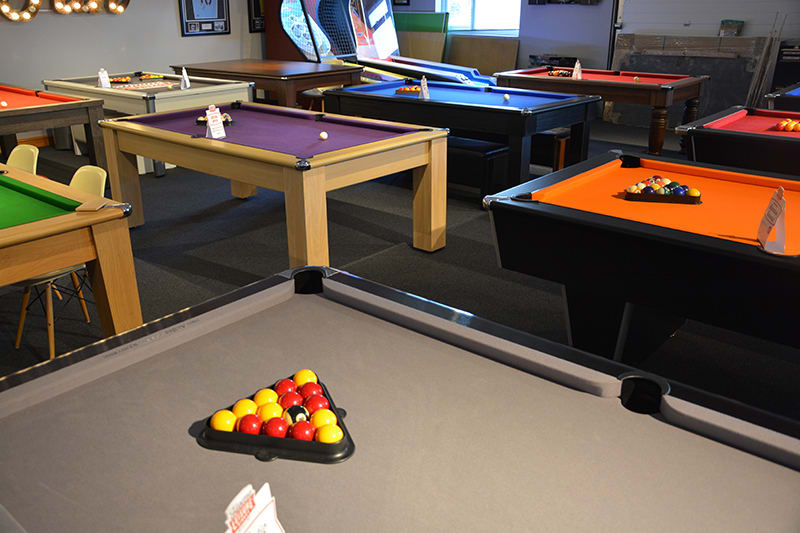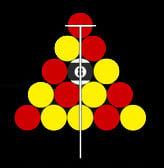The Supreme Pool Series rules have been unveiled!
The Supreme Pool Series 2018, run by Players Pool Events, is the newest competition in the world of pool and promises to be a huge and hotly-contested event. Here at Home Leisure Direct we are sponsoring the Grand Final, which uses the brand new Supreme Pool rules. With an incredible £125,000 prize fund, everyone will be studying these rules in the hope of gaining an advantage!

The Supreme Pool Series incorporates two rounds of World Rules play and two rounds of Black Ball play, before bringing everyone together in the Grand Final with the Supreme Pool rules. These new rules are designed to utilise the best of both existing rule sets and not sway the tournament in favour of World Rules or Black Ball specialists, and will be contested in a double elimination competition to finish off the series.
The first round will be played in May 2018, so the players will be brushing up already on their techniques. They still have some time to get used to the new Supreme Pool rules, as the Home Leisure Direct Grand Final will take place from November 30th to December 2nd, 2018. Read on to see the complete rules for yourself and start practising!


If you're looking to get your own pool table for competition practice, or just for fun at home, we have a huge selection available.

English Pool Tables
American Pool Tables
Pool Dining Tables
Luxury Pool Tables
Our Sales Team contact information:
Phone : 0800 622 6464 or 01454 413636
Email: [email protected] or [email protected]
SUPREME POOL RULES:
1 - SPIRIT OF THE GAME
The game shall be known as Supreme Pool. Supreme rules should be played in a sporting manner at all times.
2 - EQUIPMENT & TABLE LAYOUT
All equipment that is generally accepted throughout the industry is permitted. No other equipment is allowed unless ratified by the Tournament Director.
However, using any equipment in a non-customary manner is never allowed and constitutes a foul.
Supreme Pool is played on a six pocket rectangular table with six cushions.
Equipment permitted:
- A spotted white called a cue ball
- Two groups of object balls consisting of seven reds and seven yellows
- A striped eight ball
- Spider, rest, gooseneck rest, cross rest
- Prescribed cues
The playing surface is the flat part of the table bordered by the cushions.
The surface should be marked with an eight ball spot at the intersection of two imaginary diagonal lines joining the centre and corner pockets.
The surface should be marked with a ‘T’ racking marker. The 60mm parallel of the T going through the top spot for top ball of the rack parallel to the top cushion and the 280mm vertical line going down through the eight ball spot towards the top cushion (See Rule 5 for an illustration of the ’T’ Marker).
The cloth is marked with a break line parallel to the bottom cushion 1/5th of the length of the table away from baulk cushion.
3 - THE OBJECT OF THE GAME
Supreme pool is played with a spotted cue ball and fifteen object balls, seven red, seven yellow and a striped eight ball.
One player must pocket all balls of one group, while the other player must pocket the alternate coloured balls. The player who pockets their entire group and THEN legally pockets the eight ball wins the game. The eight ball must be potted in a separate shot.
4 - THE BREAK
4a - A “Lag for Break” shall determine who breaks first with an alternating break format taking place thereafter. The winner of lag is the player whose ball is closest to baulk cushion. The winner of the lag is given the choice to break or not.
4b - Lagging Procedure:
- Balls shall be of equal size and weight
- To start the lag the referee will count the players in by counting back from 3 to 1.
- The players must simultaneously strike balls on the referee’s indication towards the top cushion.
4c - It is automatic loss of lag if a ball:
- Crosses into the opponent’s half of the table.
- Fails to contact the top cushion.
- Drops into a pocket.
- Hits a side cushion.
- Jumps from the table.
- Comes to rest on the playing surface within the area of the corner pocket.
- Player commits any standard foul.
4d - Players will lag again if:
- Both players foul.
- The referee cannot decide on which is closest to the bottom cushion.
- The referee calls a VOID LAG because one player's ball strikes the top cushion before the other player’s ball is hit.
4e - The Break will be deemed a "Legal Break" if:
- At least one group is potted.
- Four object balls (minimum) are driven to a cushion.
4f - Failure to perform a legal break MUST result in a re-rack. The opponent has the option to break or to choose to give the break back to the original breaker.
4g - Groups are not decided on the break. Table remains open after the break. If player in control of the table does not make a legal pot table is still deemed open for the incoming player.
4h - If the eight ball is potted off the break, it is re-spotted if:
One or more of the groups are also potted, the breaker keeps control of the table and continues visit.
No group is potted, the breaker loses control of table.
To re-spot the eight ball, the centre point of the eight ball is placed on the eight ball spot or if this is not available as near as possible to the spot in a direct line between the spot and the centre of the top cushion.
If there is no space available on this line, place the eight ball as near as possible to its spot in a direct line between the spot and the baulk cushion.
4i - “In - off " on a legal break results in the incoming player being awarded one visit with cue ball to be played from behind the break line, in any direction.
5 - THE RACK
Arrange as shown with the eight ball on the eight ball spot. Top apex ball on the centre of ’T' marker. (See the diagram for an illustration of where the balls should be racked in relation to the 'T' Marker).

6 - IN PLAY
6a - Deciding groups
- Groups are decided on the first ball legally potted. Referee will call first group in play. See 6e(13)
- The table is always open immediately after the break shot. Balls potted from the break are disregarded. The player’s designated group (red or yellow) will not be determined until a player legally pockets an object ball. The table is considered an “open” table when the choice of groups (red or yellow) has not yet been determined.
- Failure to make a legal pot result in the table remaining open.
- If one of each group is potted in one shot, the player will be 'on' the group struck by the cue ball first unless a foul has occurred, in which case the table remains open.
- Where the choice of group is not obvious. (e.g. player cues up to a group of object balls/object balls of both groups sitting close to each other/player is snookered behind the eight ball/the lay of the table is such no object ball is a clear target).
- a) The player MUST indicate to the referee and/or the opponent the intended group.
- b) Failure to strike called group is loss of turn, table remains open.
- c) Striking called group but potting other group is loss of turn, table remains open.
- d) Potting called group is a legal pot and group is assigned to striker.
- e) The onus is on the player in control of the table to make the call in order for the groups to be decided in a fair and sporting manner.
- Simultaneous contact is allowed so in the case of a 50/50 ball the player will be deemed to be 'on' the called group.
- Groups are not decided on a foul shot.
6b - Completing a frame
In the course of play if the balls are potted and a legal shot is played, the players are entitled to an additional shot.
Play continues until a player:
- (a) Fails to pot one or more of the allotted balls and/or
- (b) Commits a foul.
6c - Combination shots
Two or more object balls can be potted without penalty in a single 'combination' shot. The potted balls may drop into the pockets in any order but 'on' ball must be struck legally first.
Attempting to complete a combination shot that results in only potting ball not 'on' is LOSS OF TURN.
Combination shots do not have to be called.
6d - Loss of turn
As long as the player strikes an 'on' ball first, should an opponent’s ball be potted, it will be loss of turn.
Control of the table returns to the opponent; cue ball is played from where it lies.
For example:
Potting an opponent's ball accidentally.
Failing to complete a legal combination shot.
A tactical shot e.g. playing designated group legally to pot an opponent’s ball.
6e - Standard fouls
Standard fouls are to be called by the referee as soon as they occur, the fouled player is in control, until all balls from that shot come to rest.
The referee then awards cue ball in hand, can be placed anywhere on the table with one visit to the opponent.
- Potting the Cue Ball - "In Off" (Except off the break, see 4i)
- Playing from outside Baulk when obliged to play from Baulk. The break line is considered to be part of the baulk. The base of the cue ball must be on or behind the break line.
- A player who plays a shot immediately after playing a foul or immediately after the referee has called a foul on that player, has played out of turn. This also covers breaking out of turn.
- Striking the Cue Ball with any part of the cue other than the tip in general play. Positioning the cue ball with the cue after a foul is allowed as long as the tip of the cue is not used.
- Striking an Object Ball with any part of the cue or cue tip.
- Playing a shot before all balls have come to rest from the previous shot.
- Playing a shot before any balls that require re-spotting or replacing, have been re-spotted or replaced. (See 6l).
- Coaching: During a frame, a player is required to play without receiving any advice from other persons relating to the playing of the frame. Should a team member or bone-fide supporter of a player offer advice, the referee will issue a "First and final warning" to that person that a repetition will result in the player being penalised via a Standard Foul. Because it may not always be possible for the Referee to hear if a statement made to a player is advice, the referee may issue the first and final warning on the grounds that any statement made to a player, other than general barracking, is deemed to be coaching. In a tournament setting, a First and Final warning may be given once only, before the commencement of the day's play as a block warning to all players and spectators.
- Leaving the playing area without permission. If a player needs to leave the playing area during a frame or match, "Time Out" must firstly be granted by the referee. Timeout may be called for:
- (a) Player requests a rest or bridge.
- (b) Something or someone is obstructing the player.
- (c) The referee has to make a decision.
- (d) The referee has to replace or re-spot a ball.
- Playing a shot after neglecting to call choice of group when required to do so by a referee / opponent. See Rule 6a(5).
- Playing a “Push Shot” (defined as when the tip of the cue remaining in contact with the cue ball once it has commenced a forward motion).
- Double hit.
- Failing to perform a “Legal Shot”. DEFINITION OF A LEGAL SHOT - To play a legal shot the player must cause the cue balls initial contact to be with a ball 'on' and THEN must either:
- Pot any ball or balls or
- Cause the cue ball or any object ball to contact a cushion.
- Playing a shot while not having at least one foot touching the floor.
- Failing to "Play Away" from a touching ball(s).
- A ball remaining off the table.
- Players body or clothing touching any ball.
- Jump shot: If the cue ball leaves the bed of the table and does not strike an object ball that it would have struck had the cue ball not left the table on an otherwise identical shot, then the cue ball is deemed to have jumped over that ball.
- Marking the table to assist a shot.
- Time foul.
6f - Loss of frame fouls
- Deliberately striking / potting an opponent’s ball(s).
- Unsporting behaviour / bringing the game into disrepute, including but not exclusive to:
- (a) Foul language.
- (b) Throwing a cue around / unscrewing as if to concede.
- (c) Continually arguing with the referee or opponent.
- (d) Interfering when the opponent is on the shot either verbally or physically.
- Committing a foul in the same shot that the eight ball is potted. (Except on the break)
- Potting the Eight Ball when a ball or balls of the player's own group are still on the table (except on the Break), including potting last group ball and eight ball in same shot.
- A player who clearly and intentionally fails to make an attempt to play a ball(s) of his/her own group.
- Intentionally positioning the cue ball in hand after a foul to create a re-rack situation.
6g - Stalemate situation
Should any situation arise whereby a legal shot cannot be played, Rule 6e(13), whether this situation is arrived at by accident or design, the frame shall be restarted with a 15 ball rack.
The players will re-lag to determine who will break.
6g - Frozen balls
- An object ball is deemed frozen whilst touching a cushion. It is a foul if the shot does not result in:
- A ball being potted or
- The cue ball contacting a cushion or
- The frozen ball contacting a cushion attached to a different rail or
- Any other object ball contacting a cushion with which it was not already in contact with before the shot is played.
- A ball is only deemed frozen if announced by the referee or player, prior to the shot being taken.
6h - Outside Interference
- There is no penalty if balls are moved in these circumstances:
- (a) By persons other than players taking part in the frame or
- (b) As a result of players being bumped or
- (c) Events deemed not within a players control.
- The referee will return the balls as close as possible to their original positions whenever possible. Re-racks should only be granted in extreme circumstances. The referee’s decision is final.
- The referee can reset the shot clock if they consider situation warrants. The decision is at referee’s discretion.
6i - Shot clock
Each player is allotted 45 seconds for each shot. The tip of the cue must have made contact with the cue ball within this time or a standard foul shall be granted to the opponent. The shot clock is to be started once all balls come to rest. The time keeper shall call at 10 second mark has been reached, then count down from 5 seconds.
One extension per frame is permitted per player. Referee will reset clock at time of request to 45 seconds.
6j - Balls falling into a pocket without being hit
If an object ball hangs in a pocket and drops in 5 seconds or less after coming to complete rest by the hole, the ball is considered to be pocketed. If a hanging ball drops in the pocket after being at rest for more than 5 seconds, the ball is returned to the original position on the edge, and the incoming player may begin his/her inning. The referee’s decision is final.
If a ball falls into a pocket without being no part of any shot in progress it shall be replaced and play continued.
If a ball falls into a pocket by itself during a shot so that it would have been hit by another ball had that ball still been there, all balls are to be replaced to their original positions before the shot was taken and the player then may replay the shot or choose a different shot if they so wish.
6k - Balls off the table
It is a foul if a ball leaves the playing surface and does not return by its own means and remains off the playing surface (other than being potted)
- If a cue ball it is ball in hand, can be played anywhere on the table.
- Object balls are re-spotted.
6l - Re-spotting and returning balls to the table
An object ball is re-spotted with its centre point on the eight ball spot or as near as possible to that spot in a direct line between the spot and the centre point of the top cushion.
Object balls are re-spotted in the following order:
- (a) Eight ball
- (b) Red
- (c) Yellow
Return balls as close as possible to other balls without touching.
6m - Player responsibility
It is the responsibility of each player to be aware of all rules. However, a referee on request may advise on the rules of the game but must not provide any subjective opinion that would affect the result of the frame. Tournament officials will make every reasonable effort to make the information readily available to all players. However, the ultimate responsibility rests with each individual player. There is no recourse if a player does not obtain correct or complete information.
Players may always call for rule(s) clarification during play. However, this is not considered a “Time Out”.
7 - COMPLETION OF A FRAME
A frame is over when the eight ball is potted on a legal shot and all the balls have come to rest or in a loss of frame situation.
The referee waits for all the balls to stop moving and announces FRAME. If the referee has not made this announcement, then a player will be penalised by LOSS OF FRAME if a further shot is played or the player interferes with the remaining balls.
 Download Supreme Pool Rules...
Download Supreme Pool Rules...
Written By: Dave Morgan